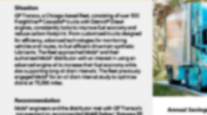Trump Administration Said to Eye Big Cuts to Fuel Economy Rules

President Donald Trump’s administration is looking at ways to reduce future fuel economy standards for automobiles in a move to appease carmakers, who have asked to ease targets put in place under President Barack Obama.
The National Highway Traffic Safety Administration is looking at a range of options to lower future targets, including one that would permit an average fleetwide fuel economy standard of 35.7 miles per gallon by 2026, down from the 46.6 miles per gallon under rules charted by the Obama administration, according to a draft NHTSA analysis obtained by Bloomberg News.
Under that scenario, the agency projects an estimated 10% of new cars and light trucks sold in 2030 would need to be hybrid or plug-in electric to comply with the standards. That compares to 61 percent under the Obama-era proposal, according to the document.
The draft analysis, dated Jan. 22, outlines several alternatives to NHTSA fuel economy standards for upcoming model years that were charted during the Obama administration. Other scenarios offer less aggressive cuts to future standards. The document doesn’t specify a preferred scenario.
The draft also indicates NHTSA may propose standards for as early as the 2021 model year and as far in the future as model year 2026, giving automakers additional time to achieve reductions in fuel consumption.
The documents provide a glimpse into negotiations now going on between NHTSA, the Environmental Protection Agency and California regulators over the fate of one of the Obama administration’s signature environmental policies. At the end of March, NHTSA plans to begin the process of putting rules in place that will set new fuel economy rules for 2022 to 2025.
The proposal could set the Trump administration on a collision course with California regulators, who have vowed to defend their own efficiency standards. Automakers are hoping to maintain consistent standards nationwide, which would require federal regulators and state officials to agree on any changes to the rules. Failing to strike a deal could lead to a messy court battle and leave industry rules under a cloud of uncertainty.
California Responds
In a statement Feb. 10, a spokesman for the California Air Resources Board said the state has received no proposals or analyses from the Trump administration about possible changes to federal standards and won’t make a specific comment until it does.
However, California remains convinced that greater fuel economy and more electric cars — not fewer — are needed to protect the public health, address climate change, and save consumers money at the pump, according to Stanley Young, the ARB spokesman.
“It’s clear that in order to stay competitive globally, the U.S. auto industry needs to keep pace with the rest of the world. That’s where California is moving,” Young said. “It is unwise for the federal government to set the clock of automotive technology back a decade.”
Requests for comment left with NHTSA and Transportation Department spokeswomen weren’t returned Feb. 9.
NHTSA’s Corporate Average Fuel Economy standards were first enacted in the aftermath of the 1973 Arab oil embargo. In 2009, they were linked with tailpipe greenhouse gas emissions standards set by the EPA and the ARB under a deal brokered by the Obama administration.
Automakers in 2011 again agreed to a trio of coordinated rules overseen by the EPA, NHTSA and the ARB that get more stringent each year, and extended them until 2025 when they arrive at a fleet average of more than 50 miles per gallon. That’s equivalent to about 36 miles per gallon in real-world driving.
Automakers have aggressively lobbied Trump to take a new look at the standards that they say need adjustments in light of surging light-truck sales, low gasoline prices and tepid demand for plug-in vehicles.




